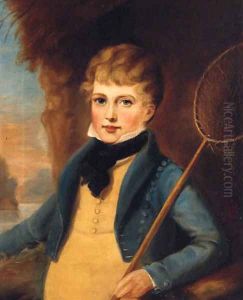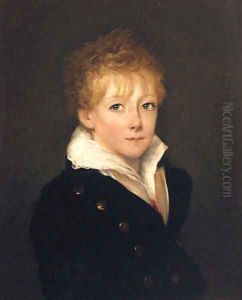Of William Owen Paintings
William Owen, born in 1769 in Ludlow, Shropshire, England, was a distinguished British portrait painter whose career spanned the late 18th and early 19th centuries. Owen's talent for capturing the essence and personality of his sitters made him a sought-after portraitist among the British elite. His ability to depict his subjects with a combination of realism and flattery earned him significant recognition and patronage throughout his career.
Owen began his formal art education at the Royal Academy Schools in London in 1786, where he honed his skills and absorbed the influence of leading artists of the time. His early work quickly garnered attention, leading to a steady flow of commissions from notable figures of the period. In 1792, his talent was officially recognized when he was awarded a premium by the British Institution, a significant achievement for a young artist of his time.
Throughout the early 1800s, Owen's reputation continued to grow. He was appointed as the Portrait Painter to the Prince of Wales, later King George IV, which significantly boosted his standing and clientele. In 1806, he was elected a Royal Academician, a prestigious honor that solidified his place among the elite of British art. His portraits were known for their sophisticated elegance and attention to detail, characteristics that made them highly valued among his contemporaries.
Owen's subjects included many of the leading figures of his day, from aristocrats and politicians to scholars and military heroes. Despite his focus on portraiture, he occasionally painted historical and mythological scenes, showing a versatility and depth of skill that went beyond his primary genre. His work is characterized by a soft, yet precise, handling of light and shadow, a technique that brought a lifelike quality to his paintings.
William Owen's contribution to British art was cut short by his untimely death in 1825. However, his legacy endured through his influential portraits, which continue to be celebrated for their artistic merit and historical significance. Owen's work is held in high esteem in several public and private collections, including the National Portrait Gallery in London, where his portraits serve as a window into the cultural and societal nuances of early 19th-century Britain.

